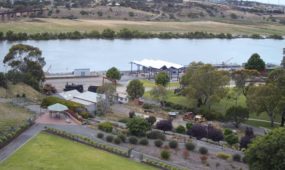Jurassic World: if you make a monster it will always bite back
Uncategorized
Jurassic World brings to life the fantasy of an amusement park where genetically engineered dinosaurs are the main attraction, as first imagined in the original book, then movie Jurassic Park back in 1993. This fourth movie in the franchise, in cinemas from today, is certainly action-packed, although there are a number of opportunities missed when it comes to how these beasts are represented.

Sign up to receive notifications about new stories in this category.
Thank you for subscribing to story notifications.
Jurassic Worldoriginal bookJurassic Park
Jurassic World’s dinosaurs are analogous to Frankenstein’s monster, and they unleash the catastrophic consequences we expect when hubristic scientists become obsessed with forbidden knowledge. In this case, by tampering with the laws of nature to create new life forms for dubious ends.
The beasts are spectacular though. And like Mary Shelley’s monster, they are imperfect products of their environment.
The first three Jurassic Park movies went to great lengths to present dinosaurs that were as close to being real as the latest scientific interpretation of the time allowed. Leading palaeontologists were consulted to show how up-to-date the current thinking was on dinosaurs.
Although not 100% perfect, the end result was creatures that were accurate, to the best of our knowledge, and vividly realistic. Many a palaeontologist was brought close to tears by the life-like reconstructions facilitated by the advances of digital animation technologies.
Jurassic World, however, commits some fairly serious errors in dinosaur reconstruction. Impressive though the beasts may be, whoever was behind their creation has ignored many recent breakthroughs in dinosaur science.
As renowned dinosaur expert Tom Holtz, of the University of Maryland, told us:
Jurassic Park brought the understanding of dinosaurs of the 1980s to the movie goers of the 1990s. Jurassic World brings the understanding of dinosaurs of before the 1980s to the movie goers of 2015.
Bigger, louder and with more teeth
Both the scientists in Jurassic World and the film makers responsible for its creation have something in common: the pressure of their consumers for more spectacular product.
Ostensibly, the creation of the genetically engineered hybrid monster theropod of Jurassic World, the Indominus rex, is driven to satisfy the ever-increasing appetite for novelty of the visitors, who we are told have already become bored by the spectacle of living dinosaurs. And we don’t have to wait long before we see what happens when the tables are turned and Indominus, and its appetite, is unleashed.
Many of the other dinosaurs depicted in the film are accurately recreated, and we do have to be mindful that this is a fiction presenting a world built on an impossible premise of being able to recreate animals we are still learning more about each year. It’s no surprise the film makers find it hard to keep up.
Creative differences
Despite the involvement of expert palaeontologist Dr Jack Horner advising on the film, certain obvious omissions beyond his control will cause consternation to many a die-hard dinosaur fanatic.
For example, we now have many kinds of theropod dinosaurs showing well-preserved feathers, especially in forms close to Velociraptor (for example Microraptor), Gallimimus (Ornithomimus had feathers) and even close relatives of Tyrannosaurus had feathers (Yutyrannus). So why don’t any of the theropod dinosaurs in the movie have feathers?
Our first view of Stegosaurus in the new movie shows the tail held high above the ground as it should be, but in a later scene we see Stegosaurus dragging their tails on the ground. This ignores research showing that they held the tails aloft, as evinced by well-preserved trackways lacking tail drag marks.
The flying pterosaurs are very well done, and appear realistic in physical appearance, but lose out on their behaviour.
Fish eaters such as Pteranodon are seen attacking and picking up humans with their delicate small foot claws. Although sporting a six metre wingspan, the body of a Pteranodon weighed only about 12kg to 15kg. So the idea of them picking up any people would be like a paper aeroplane picking up a puppy.
Palaeontologists have been voted off the island
A major shift from the first three movies, and one that explains the absence of palaeontologists in the movie, is that this enterprise is driven by profit rather than passion. The park’s original founder, John Hammond (played by the late Richard Attenborough in the earlier movies), was an affable imperfect human, endearing in his quest to bring back the dinosaurs.
In this way he was similar to the original Dr Frankenstein, pursuing his scientific obsession with the origins of life. As the death toll mounted, he struggled to face the consequences of his actions. The true villain in the first film, though, was not Hammond, nor the rampaging dinosaurs pursuing their instincts, but the greedy Dennis Nedry, who sought to profit by selling Hammond’s dinosaur embryos to a rival.
But in this movie, Hammond and his quixotic vision is long gone. These days Jurassic World is in the hands of a corporation driven by profit and growth, the model of a modern capitalist enterprise which could be seen as the ultimate enemy of the natural world.
The site is managed by the highly intellectual Claire (Bryce Dallas Howard), as perfectly manicured and polished as she is controlled and contained. Claire is under instruction by “Corporate” to create new dinosaurs, or “assets” as they are called, in order to increase numbers through the door: visitor numbers spike whenever they create a new exhibit.
Opposite Claire is Owen (Chris Pratt), an ex-navy animal wrangler brought in to consult on the safety of enclosures. All muscle and machismo, Owen is unapologetically driven by instinct rather than intellect, and responsible for some of the cheesiest frat-boy lines we’ve had to endure in recent years.
We are led into their world of spectacle and witness a great white shark – that terrorised us for the last 40 odd years after Jaws – hung out and reduced to bait for the mosasaur that leaps from the water to take it in one gulp. The crowd is drenched by the splash this new monster generates. The barriers between the exhibit and the spectators are clearly not impermeable.
We need a hero
As Jurassic World starts to come apart thanks to the unleashed Indominus rex, we need a capable hero to rescue the kiddies and the corporate ice-princess, who after being imprisoned in her glass office is just waiting to bust out her inner-Lara Croft.
Owen, the brawny anti-intellectual hero, demands that “if we’re going to do this, we do this my way”. Which means on a motor bike, with his raptor gang, with whom he has a relationship based on mutual respect.
The closer Claire comes to nature, the more sweaty and human she becomes, and this is the rub of the tale. The more corporate and clinical the world, the more divorced we are from nature, the more terrifying the consequences. Only Owen has retained his common sense and basic instincts.
Jurassic World presents (again) guileless humans surprised by the violence and calamity that ensues when the Pandora’s Box of science is opened. But as much as the film tries to make a bad guy out of the science, the real enemies are the humans who brought these creatures to life with less than philanthropic intent and a negligible sense of responsibility.
This discomfort has a number of parallels today, particularly regarding potential uses of genetic technologies, as well as human induced threats to our existence, such as terrorism and climate change.
Mary Shelley demonstrated nearly 200 years ago that with the power to create comes the responsibility for the consequences. Owen may be a meathead, but at the very least he is still human with a healthy respect for nature.
Forget the incongruities, such as imperfect representations of dinosaurs or the likelihood of any woman in Claire’s heels being able to outrun a T. rex., Jurassic World is still an enjoyable Hollywood tumble through the world of wonder and potential of science, nature and human beings.
The three are not mutually exclusive, and when united can conquer, create or destroy. The trouble is we don’t always know the consequences until it’s too late.
John Long is Strategic Professor in Palaeontology at Flinders University.Heather L. Robinson is Research Associate & PhD Candidate, School of Humanities and Creative Arts at Flinders University.
This article was originally published on The Conversation. Read the original article.
Jump to next article



